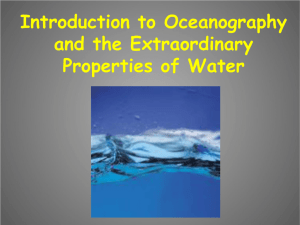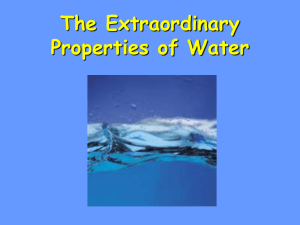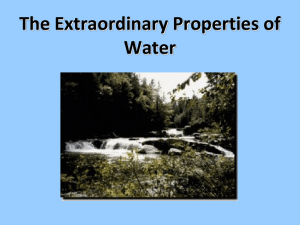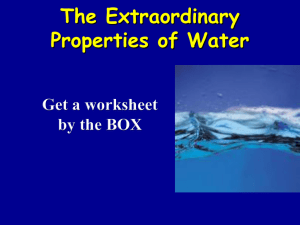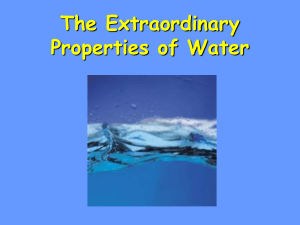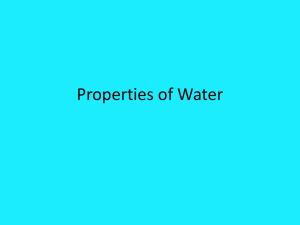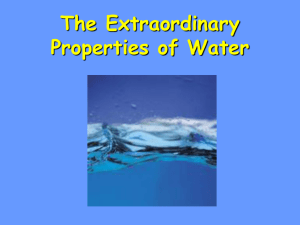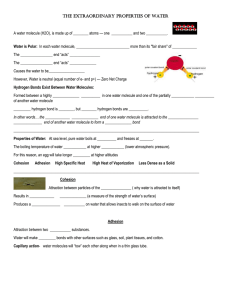Waterproperties
advertisement
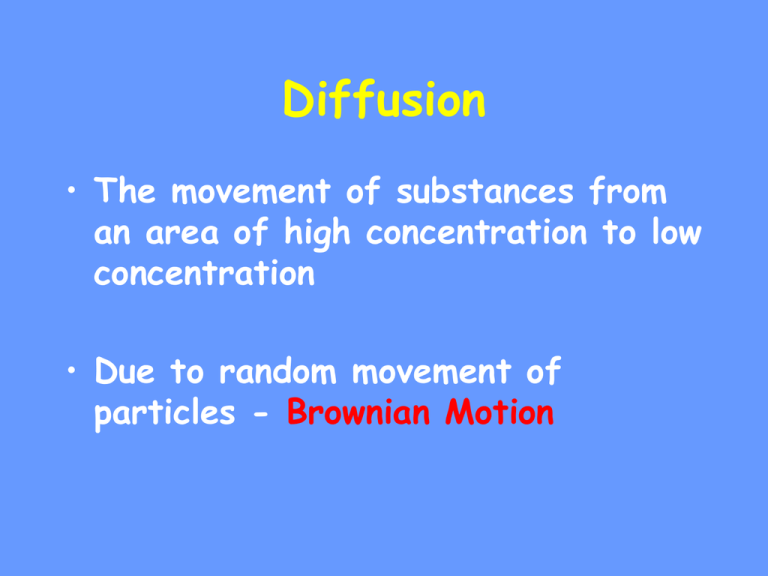
Diffusion • The movement of substances from an area of high concentration to low concentration • Due to random movement of particles - Brownian Motion The results of diffusion • Particles will move until they’re evenly spread out – no concentration gradient • But there’s still movement! They’re always moving! This is called dynamic equilibrium – they’re moving but nothing is really changing The Extraordinary Properties of Water Water • A water molecule (H2O), is made up of three atoms: one oxygen and two hydrogen. H H O Hydrogen Bonds -formed between a highly electronegative atom of a polar molecule and a Hydrogen -one hydrogen bond is weak , but many hydrogen bonds are strong Properties of Water •At sea level, pure water boils at 100 °C and freezes at 0 °C. •The boiling temperature of water decreases at higher elevations (lower atmospheric pressure). •For this reason, an egg will take longer to boil at higher altitudes. Properties of Water • What are they? Properties of Water • Cohesion Properties of Water • Cohesion • Adhesion Properties of Water • Cohesion • Adhesion • High Specific Heat Properties of Water • Cohesion • Adhesion • High Specific Heat • High Heat of Vaporization Properties of Water • Cohesion • Adhesion • High Specific Heat • High Heat of Vaporization • Less Dense as a Solid Cohesion •Attraction between particles of the same substance - why water is attracted to itself Results in: Surface tension (a measure of the strength of water’s surface) •surface film on water -allows insects to walk on the surface of water Adhesion •Attraction between two different substances. - water will make hydrogen bonds with other surfaces such as glass, soil, plant tissues, and cotton. •Capillary action-water molecules will “tow” each other along when in a thin glass tube. - i.e. transpiration process which plants and trees remove water from the soil, and paper towels soak up water. High Specific Heat Amount of heat needed to raise or lower 1g of a substance 1° C. •Water resists temperature change, both for heating and cooling. •Water can absorb or release large amounts of heat energy with little change in actual temperature. High Heat of Vaporization Amount of energy to convert 1g or a substance from a liquid to a gas • In order for water to evaporate, hydrogen bonds must be broken. As water evaporates, it removes a lot of heat with it. • “Water vapor forms a kind of global ‘blanket’ which helps to keep the earth warm. Heat radiated from the sun-warmed surface of the earth is absorbed and held by the vapor.” Water is Less Dense as a Solid •Ice is less dense as a solid than as a liquid (ice floats) Liquid water has hydrogen bonds that are constantly being broken and reformed. Frozen water forms a crystal-like lattice whereby molecules are set at fixed distances. Water is Less Dense as a Solid •Which is ice and which is water? Water is Less Dense as a Solid Water Ice Homeostasis • Ability to maintain a steady state despite changing conditions • Water is important to this process because: a. Makes a good insulator b. Resists temperature change c. Universal solvent d. Coolant e. Ice protects against temperature extremes Universal Solvent • Water has the ability to dissolve most substances. • Solvent – does the dissolving • Solute – is being dissolved • Solution – a mixture in which one or more other substances (solutes) are distributed evenly in another substance (solvent) pH • The measure of how acidic or basic something is • Acid – any substance that forms hydrogen ions (H+ ) in water – (pH below 7) • Base- any substance that forms hydroxide ions (OH-) in water – (pH above 7) The pH Scale • Turn to page 154 in your books to have a look at the pH scale • What types of substances are acidic? What types of substances are basic? • Let’s test some, shall we? Activity • Complete Mini-Lab 6-1 on page 155
